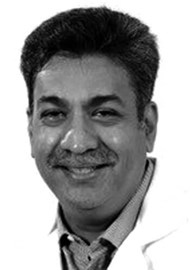The field of healthcare has a substantial impact on the environment as it is responsible for 5-10% of greenhouse gas emissions and 9% of air pollutant generation [1]. Surgery is associated with the rapid consumption of single-use products and waste accumulation. Ophthalmic surgery, in particular cataract surgery, is performed at high volumes, given that cataracts are the most common cause of visual impairment and blindness worldwide [2]. Cataract procedural volume is growing at a compounded rate of 3.1% per year, likely driven by demographic changes and increased healthcare access.
The adoption of sustainable practices by healthcare systems may have a substantial impact on the environment. Institution-wide practices at the Aravind Eye Care System provide a remarkable model of surgical excellence, environmentally-sustainable practices, financial and social success [3]. For example, each phacoemulsification procedure at Aravind produces about 5% of the greenhouse gases when compared to one phacoemulsification in the UK [3,4]. Importantly, surgical outcomes at Aravind are equivalent to Western countries [5,6].

Figure 1: Aravind Eye Hospital, Pondicherry, India.
The Aravind Eye Hospital began in 1976 with an 11-bed hospital and has evolved to a large healthcare system. Aravind is comprised of multiple centres that provide varying levels of care, with 15,000 outpatient clinic visits and 2000 surgeries on a typical day. This hub and spokes model allows for primary eyecare access close to the patients’ communities through vision centres and outreach camps, minimising the need for travel and lowering the carbon footprint associated with care. Approximately 85% of ophthalmic complaints are solved at primary care sites, while 15% are referred to the secondary or tertiary centres for lasers, surgery or subspecialty care. Aravind’s social, environmental and financial interests work synergistically and remarkably, 50% of surgeries are free or steeply subsidised.
Workflow at Aravind allows for all examination and testing to be performed on the same day, including subspecialty consultations. Additionally, treatment options such as laser peripheral iridotomy, laser and injections for diabetic retinopathy and spectacle preparation are offered as same-day procedures, while cataract surgery is offered as a next-day procedure.


Figure 2 and 3: An average of 2000 surgeries are performed per surgeon per year.
Aravind’s strategies for efficient surgical delivery include optimisation of the physical layout of operating rooms, specialisation of tasks, standardisation of practices, reduction of waste, maximisation of reusable materials, all while maintaining safety and quality. Operating room protocols that reduce surgical waste include the use of reusable surgical instruments, reusable operating room attire, multiuse solutions during cataract surgery, multiuse preoperative eyedrops [3]. One surgeon operates on two tables with the help of two scrub nurses and performs six to eight surgeries per hour, leading to an average of 2000 cases per surgeon per year (Figures 2 and 3). Additionally, surgical materials are thoughtfully reused and recycled (Figures 4 and 5). Instruments such as syringes and surgical cannulas are flash autoclaved in between cases and undergo a full autoclave cycle at the end of the day. Vitrectomy materials, phacoemulsification tubing and phacoemulsification probes are sterilised and optimally reused three to four times. Surgical gowns are used for multiple cases and are laundered once per day.


Figure 4 and 5: Surgical materials are thoughtfully reused and recycled.
The optimisation of patient care practices across the institution has led to significant reduction of our carbon footprint. For example, obtaining spectacles at a vision centre prior to optimisation involved in-person selection of frames, which were sent to a central lab at the base hospital to be fit with lenses, and then delivered back to the vision centre. This process was associated with a six-day wait time, carbon emissions associated with the transport of materials and substantial cost. The current improved practice involves selection of the frame via an online catalogue; the selection is emailed to the lab at the base hospital, where the lens is fit on the selected frame and the prepared glasses are sent to the vision centre. This process takes just one day and reduces the carbon footprint of glasses preparation and delivery.
In addition to environmentally-sustainable medical care, Aravind prioritises responsible consumption across the institution as per World Health Organization guidelines. The building design is responsive to local climate conditions and optimised for reduced energy and resource demands. Air conditioning is used only in certain key areas and all lighting has been converted to LED. The solar plant at Aravind-Pondicherry produces 60% of the energy required at the site. Aravind promotes walking or bicycling and encourages the use of public transport by staff, patients and the surrounding community. The hospital vehicle fleet exclusively uses alternative fuels. Additionally, dining services at Aravind are comprised of sustainable, locally-grown materials and every effort is made to conserve potable water, harvest rain water and treat waste water. These practices are not only environmentally-sustainable with significant benefit for the people and the planet, but are also economically feasible. Aravind’s social, environmental and financial interests work synergistically.
Central to Aravind’s success in environmentally-sustainable practices is a high level of commitment from its leadership. The ‘5R Practice’ established at Aravind includes Reducing the amount of waste produced, Reusing materials, Recycling waste at the source, Repairing and performing preventive maintenance and Rethinking current practices. Aravind leadership is committed to raising staff awareness and engagement, identifying and implementing sustainable opportunities at the institution, and propagating Aravind’s practices forward to other healthcare systems.
References
1. Eckelman MJ, Sherman J. Environmental Impacts of the U.S. Health Care System and Effects on Public Health. PLoS One 2016;11(6):e0157014.
2. Bourne RRA, Stevens GA, White RA, et al. Causes of vision loss worldwide, 1990-2010: a systematic analysis. Lancet Glob Health 2013;1(6):e339-49.
3. Thiel CL, Schehlein E, Ravilla T, et al. Cataract surgery and environmental sustainability: Waste and lifecycle assessment of phacoemulsification at a private healthcare facility. J Cataract Refract Surg 2017;43(11):1391-8.
4. Morris DS, Wright T, Somner JEA, Connor A. The carbon footprint of cataract surgery. Eye (Lond) 2013;27(4):495-501.
5. Haripriya A, Chang DF, Ravindran RD. Endophthalmitis reduction with intracameral moxifloxacin in eyes with and without surgical complications: Results from 2 million consecutive cataract surgeries. J Cataract Refract Surg 2019;45(9):1226-33.
6. Pershing S, Lum F, Hsu S, et al. Endophthalmitis after Cataract Surgery in the United States: A Report from the Intelligent Research in Sight Registry, 2013-2017. Ophthalmology 2020;127(2):151-8.
COMMENTS ARE WELCOME







